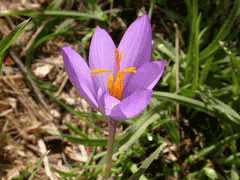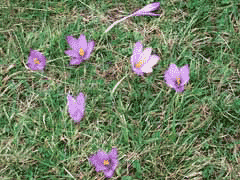 |
|
http://commons.wikimedia.org/wiki/User:Simonjoan |
 |
| http://commons.wikimedia.org/wiki/User:Simonjoan |
Translate this page:
Summary
Physical Characteristics

 Crocus nudiflorus is a CORM growing to 0.2 m (0ft 8in).
Crocus nudiflorus is a CORM growing to 0.2 m (0ft 8in).
See above for USDA hardiness. It is hardy to UK zone 5 and is not frost tender. It is in flower from September to October. The species is hermaphrodite (has both male and female organs) and is pollinated by Bees, butterflies.
Suitable for: light (sandy) and medium (loamy) soils, prefers well-drained soil and can grow in nutritionally poor soil. Suitable pH: mildly acid, neutral and basic (mildly alkaline) soils and can grow in very alkaline soils.
It can grow in semi-shade (light woodland) or no shade. It prefers dry or moist soil.
UK Hardiness Map
US Hardiness Map
Synonyms
Plant Habitats
Woodland Garden Dappled Shade; Lawn; Cultivated Beds;
Edible Uses
Edible Parts:
Edible Uses: Colouring Condiment Tea
This species has been used as a saffron substitute[200]. The following notes are for the genuine saffron, C. sativus:- The flower styles are used as a flavouring and yellow colouring for various foods such as bread, soups, sauces, rice and puddings[2, 4, 7, 14, 21, 27, 34, 183]. Extremely rich in riboflavin[137]. Water soluble[171]. Yields per plant are extremely low, about 4000 stigmas yield 25g of saffron[89]. Saffron is the world's most expensive spice, it takes 150,000 flowers and 400 hours work to produce 1 kilo of dried saffron[238]. About 25 kilos of styles can be harvested from a hectare of the plant[4]. The flower styles are used as a tea substitute[183].
References More on Edible Uses
Medicinal Uses
Plants For A Future can not take any responsibility for any adverse effects from the use of plants. Always seek advice from a professional before using a plant medicinally.
Anodyne Antispasmodic Aphrodisiac Appetizer Carminative Diaphoretic Emmenagogue Expectorant
Sedative
This species has been used as a saffron substitute[200]. The following notes are for the genuine saffron, C. sativus:- Saffron is a famous medicinal herb with a long history of effective use[4, 7]. The flower styles and stigmas are the parts used, but since these are very small and fiddly to harvest they are very expensive and consequently often adulterated by lesser products[7]. They are anodyne, antispasmodic, aphrodisiac, appetizer, carminative, diaphoretic, emmenagogue, expectorant, sedative and stimulant[4, 7, 21, 174, 176, 218]. They are used as a diaphoretic for children and to treat chronic haemorrhages in the uterus of adults[4]. A dental analgesic is obtained from the stigmas[7]. The styles are harvested in the autumn when the plant is in flower and are dried for later use[4], they do not store well and should be used within 12 months[238]. This remedy should be used with caution[21], large doses can be narcotic[240] and quantities of 10g or more can cause an abortion[218].
References More on Medicinal Uses
The Bookshop: Edible Plant Books
Our Latest books on Perennial Plants For Food Forests and Permaculture Gardens in paperback or digital formats.

Edible Tropical Plants
Food Forest Plants for Hotter Conditions: 250+ Plants For Tropical Food Forests & Permaculture Gardens.
More

Edible Temperate Plants
Plants for Your Food Forest: 500 Plants for Temperate Food Forests & Permaculture Gardens.
More

More Books
PFAF have eight books available in paperback and digital formats. Browse the shop for more information.
Shop Now
Other Uses
Dye
The yellow dye obtained from the stigmas has been used for many centuries to colour cloth[4, 7, 14, 21]. It is the favoured colouring for the cloth of Indian swamis who have renounced the material world. A blue or green dye is obtained from the petals[168].
Special Uses
References More on Other Uses
Cultivation details
Prefers a well-drained sandy or loamy soil that is free from clay[137]. Prefers some shade from the hottest sun in summer and at least a modicum of moisture during its summer dormancy[200]. Succeeds in grass, so long as this is not mown until the leaves die down, it also grows well under deep-rooting deciduous trees and shrubs[200]. It can also be grown with very low shallow-rooting groundcover plants such as lawn camomile (Chamaemelum nobile 'Treneague')[200]. Plants are very frost hardy[137]. Plants tend to move considerably from their original planting place because of their means of vegetative reproduction, it is therefore wise not to grow different species in close proximity[1]. The corms should be planted about 5 - 8cm deep in the soil[200]. Any planting out is best done in late spring or early summer[245]. Plants take 4 - 5 years to come into flowering from seed. The flowers are only open during the day time, closing at night[245].
References Carbon Farming Information and Carbon Sequestration Information
Temperature Converter
Type a value in the Celsius field to convert the value to Fahrenheit:
Fahrenheit:
The PFAF Bookshop
Plants For A Future have a number of books available in paperback and digital form. Book titles include Edible Plants, Edible Perennials, Edible Trees,Edible Shrubs, Woodland Gardening, and Temperate Food Forest Plants. Our new book is Food Forest Plants For Hotter Conditions (Tropical and Sub-Tropical).
Shop Now
Plant Propagation
Seed - best sown as soon as it is ripe in a light sandy soil in pots in a cold frame[1]. The seed can also be sown in a cold frame in early spring[1]. Sow thinly because the seed usually germinates freely[1], within 1 - 6 months at 18°c[164]. Unless the seed has been sown too thickly, do not transplant the seedlings in their first year of growth, but give them regular liquid feeds to make sure they do not become deficient. Divide the small bulbs once the plants have died down, planting 2 - 3 bulbs per 8cm pot. Grow them on for another 2 years in a greenhouse or frame and plant them out into their permanent positions when dormant in late summer[K]. Plants take 3 - 4 years to flower from seed[200]. Division of the clumps after the leaves die down in spring[1, 200]. The bulbs can be replanted direct into their permanent positions if required.
Other Names
If available other names are mentioned here
Native Range
Coming Soon
Weed Potential
Right plant wrong place. We are currently updating this section.
Please note that a plant may be invasive in one area but may not in your area so it's worth checking.
Conservation Status
IUCN Red List of Threatened Plants Status :

Growth: S = slow M = medium F = fast. Soil: L = light (sandy) M = medium H = heavy (clay). pH: A = acid N = neutral B = basic (alkaline). Shade: F = full shade S = semi-shade N = no shade. Moisture: D = dry M = Moist We = wet Wa = water.
Now available:
Food Forest Plants for Mediterranean Conditions
350+ Perennial Plants For Mediterranean and Drier Food Forests and Permaculture Gardens.
[Paperback and eBook]
This is the third in Plants For A Future's series of plant guides for food forests tailored to
specific climate zones. Following volumes on temperate and tropical ecosystems, this book focuses
on species suited to Mediterranean conditions—regions with hot, dry summers and cool, wet winters,
often facing the added challenge of climate change.
Read More
Expert comment
Author
Sm.
Botanical References
200
Links / References
For a list of references used on this page please go here
Readers comment
© 2010, Plants For A Future. Plants For A Future is a charitable company limited by guarantee, registered in England and Wales. Charity No. 1057719, Company No. 3204567.